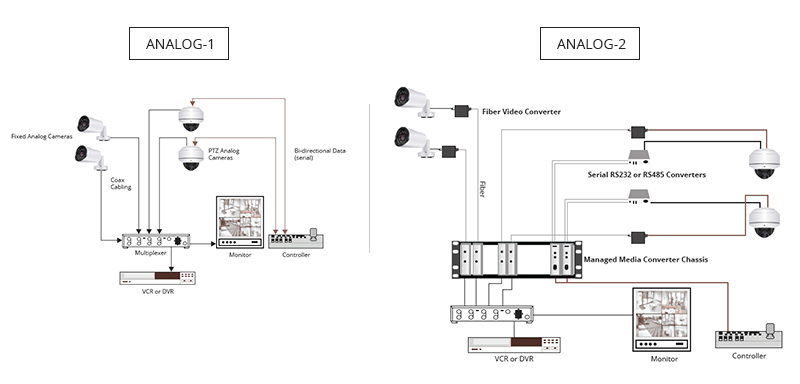Media Converter for CCTV Video and IP Video System
At present, video security and surveillance network is necessary in all walks of life. With a security system in place, it becomes easier to monitor the premises and also gather information of an incident. However, the popularity of security cameras brings new requirements on quality, bandwidth and distance capabilities of the video, which is beyond the reach of the existing copper cabling system. Here we look at a new cabling method leveraging fiber optic cabling with media converters for CCTV analog video system and IP video system.
Video Security and Surveillance Network Introduction
The increasingly popular video security and surveillance can be accomplished with a video surveillance system, which is composed of network cameras, monitors/display units, and recorders. There is an overwhelming variety of cameras that can be used for video surveillance systems, among which CCTV analog camera and video surveillance fiber IP camera are the two most commonly used devices.
CCTV Analog Video System
In a typical analog video network, fixed analog CCTV cameras are connected to a central management device (VCR—video cassette recorder or DVR—digital video recorder) via coaxial cables. If the camera has PTZ (Pan-Tilt-Zoom) function, an additional controller is added.
IP Video System
In a typical IP video surveillance network shown, IP cameras are connected directly to the local area network via UTP cabling and switches. They can send and receive data via a computer network, as opposed to sending a feed to a Digital Video Recorder (DVR). Video can be recorded by any PC or server on the network. The biggest characteristic of IP video surveillance network is that every camera has its own IP address to tell itself from the others in the whole video network. Since the cameras are IP addressable, they can be accessed from anywhere in the world.
The Necessity of Fiber Media Converter in CCTV Analog Video and IP Video System
Both types of cameras work well in either commercial or residential security. IP cameras use UTP cabling (at least Cat5), and analog cameras can use either coax or UTP (at least Cat3). These media have poorer performance than the fiber optic cabling in both the transmission distance and the bandwidth. However, it is not easy to replace the current cords with fiber optic cables. The project may encounter following challenges:
-
The Ethernet cables fixed in the wall, under the ground need to be changed by the experts
-
The legacy devices are not equipped with fiber optic ports
Given this, a more attractive fiber optic cabling method with fiber media converter for CCTV analog video system and IP video system came to professionals attention. The fiber media converter can convert the electrical video signal to an optical format. It also features the following edges:
-
Converting UTP to fiber without move or change the previous copper cabling, thus saving time and effort
-
Working as a bridge between legacy copper infrastructure and fiber-related equipment

Fig.1 The function of fiber to ethernet media converter
To recap, it can be said that the fiber media converter provides an economical path towards extending the distance of an existing network, extending the life of non-fiber based equipment, or extending the distance between two like devices.
How to Use Media Converter for CCTV Analog Video and IP Video System
Media converters come in a variety of types ranging from standard device, managed device, industrial device to PoE media converters that can not only convert optical signal to electrical signal, but also supply power to the PoE devices over a single Ethernet cable. Below are the examples that adopt the fiber media converter and the PoE media converter.
Fiber Media Converter for CCTV Analog Camera System
The following picture shows a typical analog video structure designed with fiber optic cables and media converters. To connect the fixed analog cameras to the VCR or DVR, a pair of fiber media converters should be added between the server room and cameras. Video signals will be transmitted into fiber optic signals. For analog PTZ cameras, two types of signals should be converted into fiber optic signals, one for video and one for data. Thus, two different media converters or a fiber media converter with the two functions should be installed. It is known that fiber media converters should be used in pairs. As one of the media converters is deployed on the fiber end that near the camera, the other one should be deployed on the other end near the VCR or DVR. For better management, all the fiber media converters near the server room could be installed in a managed fiber media converter rack chassis.

Fig. 2 Analog Camera System Designed Without vs With Fiber Media Converter
PoE Media Converter for IP Camera System
In the following case (shown in figure 3), PoE IP cameras are used. A pair of PoE media converters should be installed on both ends of a fiber optic cable to achieve the conversion between copper and fiber. At the computer side where the videos are recorded, a pair of Ethernet media converters should be installed. All of the fiber optic media converter for cctv near the network switches can be settled in a managed media converter chassis before connected to the switches.

Fig. 3 IP Camera System Designed Without vs With PoE Media Converter
This video shows the way to connect a PoE gigabit RJ45 to SFP converter with PoE surveillance camera and a network switch.
Conclusion
In fact, replacing the coaxial and UTP with fiber optics will improve the quality, bandwidth and distance capabilities of your video security and surveillance system. It is tempting to use fiber media converter for CCTV and IP cameras to extend the signal transmission distance while maintaining high quality images, which can also save more money and manpower or time to upgrade networks.
You might be interested in
Email Address

-
PoE vs PoE+ vs PoE++ Switch: How to Choose?
May 30, 2024













